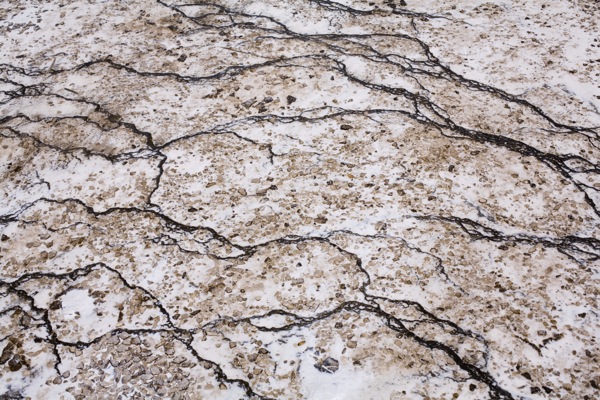What is it?
There is a class of photographs I call “texture pictures”. They don’t have a central subject on which to focus your attention; in fact, they often don’t have a subject at all. While they aren’t perfectly uniform, they do contain patterns which, in nature’s chaotic way, are repeated through the image. Sometimes, these textures are clouds, snow, water, sand, or tree bark and, as such, might be more easily recognized; other times, they can be so abstract that we don’t know what it is. Lacking easily recognized features, it is hard to get a sense of scale from the image. This drive the left brain crazy and that, in turn, gives the right brain a chuckle of amusement.
This particular photograph is of an area in the drainage of a hot spring. The lighter material is sand; the tan and more coarse material are small rocks (about centimeter-sized), and the darker material is organic matter. I used a polarizer to eliminate glare from the surface of the shallow layer of hot water.
In some ways, shots like this violate many of the traditional rules of good photography, and are sometimes accidents resulting from not paying enough attention to rules. However, what I did here was very intentional, and one of the intended results was met perfectly. I happen to spend a lot of hours in front of a computer screen each day. Desktop images (sometimes called “wallpaper”) frequently don’t work for me because I find my windows obscuring the subject of the image or, worse, I’ll avoid putting windows over the subject of the photograph, and thus reduce the effective space available on the screen. A picture like this works well on the desktop for me because I can appreciate any part of the image or the whole thing, so covering up parts of it with a window is just fine — the parts of this image which remain unobscured are sufficient to tell much of the rest of the story about the scene.
In a day of digital cameras when there are no costs for film and processing (and, thus, no costs for failure), you ought to try taking pictures of textures — parts of a bigger subject, parts which are small enough to find some repetition within the image. Although you as the photographer will have the greater context to know what you’re photographing, try to put yourself behind the eyes of the eventual viewer. Do you recognize what this is? If so, perhaps you need to move in closer. Macro lenses are great when your scene is small, but normal and telephoto lenses work fine with the many larger scenes that exhibit such patterns. Even existing pictures containing a subject may be useful; careful cropping (after the shot) may reveal images with these properties.

Tip of the Week
2007.02.05

